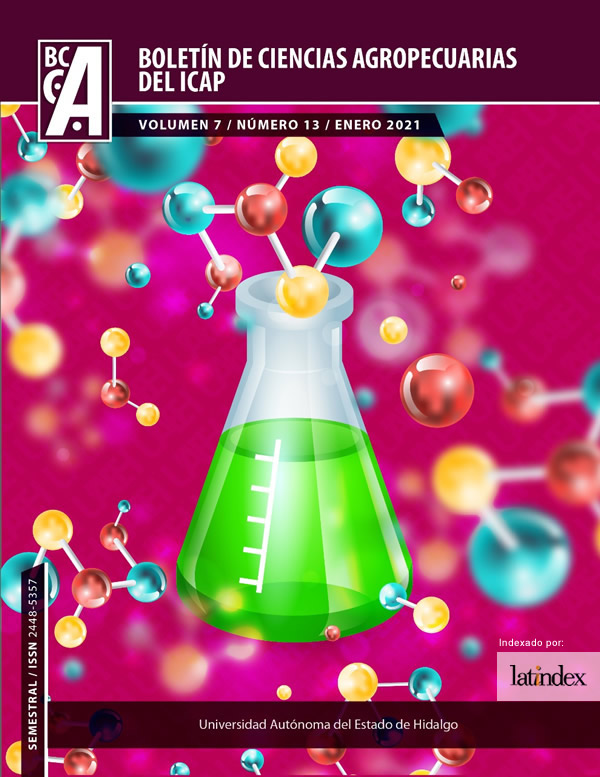Tithonia tubaeformis forage with medicinal properties, an alternative for animal feed
Abstract
Use of plants and each of its parts, within traditional Mexican medicine has transcended for many years, the wide variety of genres used creates the need for deeper research that contributes knowledge to the empirical results that are available. One of the genera that has been studied is Tithonia, which has been shown to have important bioactive properties and of pharmacological and biological interest, which is why, in this context, the tubaeformis species, a plant that is widely distributed in Mexico, considered undesirable, can become used as livestock feed and considered a botanical source for obtaining compounds of biological interest for their properties.
Downloads
References
Azmir J, Zaidul I. SM, Rahman MM, Sharif KM, Mohamed A, Sahena F, Jahurul MHA, Ghafoor K, Norulaini NAN, Omar AKM. Techniques for extraction of bioactive compounds from plant materials: A review. Journal of Food Engineering 2013; 117: 426-436. https://doi.org/10.1016/j.jfoodeng.2013.01.014
Blanco-Olano C, Olascuaga-Castillo K, Rubio-Guevara S, Valdiviezo-Campos JE. Senecio tephrosioides Turcz. (Asteraceae): Una revisión de etnobotánica, fitoquímica y farmacología. Ethnobotany Research & Applications 2020; 19: 1-14. http://dx.doi.org/10.32859/era
Botero-Londoño JM. Potencial de extracción y utilización de nutrientes de Tithonia diversifolia y su relación con el rendimiento y calidad nutricional. Tesis de Doctorado, Universidad Nacional de Colombia, Palmira, Colombia. 2017. https://repositorio.unal.edu.co/handle/unal/59441
La Duke JC. Revision of Tithonia. Rhodora 1982; 84(840): 453-522. https://www.jstor.org/stable/23314456
Greathead H. Plants and plant extracts for improving animal productivity. Proceedings of the Nutrition Society 2003; 62(2): 279–90. DOI: https://doi.org/10.1079/PNS2002197
González-Sierra L, Díaz-Solares M, Castro-Cabrera I, Fonte-Carballo L, Lugo-Morales Y, Altunaga-Pérez N. Pytochemical characterization and total antioxidant activity of different extracts from Tithonia diversifolia (Hemsl) A. Gray. Pastos y Forrajes 2019; 42(3): 227-232. https://payfo.ihatuey.cu/index.php?journal=pasto&page=article&op=view&path%5B%5D=2147&path%5B%5D=3914
Heinrich M, Robles M, West JE, Ortiz de Montellano BR, Rodríguez E. Ethnopharmacology of mexican asteraceae (compositae). Annual Review of Pharmacology and Toxicology 1998; 38: 539-65. https://doi.org/10.1146/annurev.pharmtox.38.1.539
Hinojosa JD, Gutiérrez ML, Siller FL, Rodríguez AS, Morales del Río JA, Guerrero PJM, Del Toro CLS. Screening fitoquímico y capacidad antiinflamatoria de hojas de Tithonia tubaeformis. Biotecnia Revista de Ciencias Bilógicas y de la Salud 2013;15(2): 53-60. DOI: https://doi.org/10.18633/bt.v15i2.150
Juárez VD, Cazón AV. Autotoxicidad en Tithonia tubaeformis como un posible mecanismo de control a la invasión. Ecología Austral 2003; 013(02): 133-138. http://hdl.handle.net/20.500.12110/ecologiaaustral_v013_n02_p133
Katinas L, Gutiérrez DG, Grossi MA, Crisci JV. Panorama de la familia Asteracear (=Compositae) en la República Argentina. Boletín de la Sociedad Argentina de Botánica 2007; 42(1-2): 113-129. https://www.researchgate.net/publication/242092740 .
Larenas GP, De Viana LM. Germinación y supervivencia del pasto cubano Tithonia tubaeformis (Asteraceae) en suelos contaminados con hidrocarburos de petróleo. Ecología Austral 2005; 15: 177-181. https://bibliotecadigital.exactas.uba.ar/download/ecologiaaustral/ecologiaaustral_v015_n02_p177.pdf
Mabou AT, Marino F, Cosentino M. Tithonia diversifolia (Hemsl.) A. Gray as a Medicinal Plant: A Comprehensive Review of Its Ethnopharmacology, Phytochemistry, Pharmacotoxicology and Clinical Relevance. Journal of Ethnopharmacology 2018; 220: 94-116. DOI: 10.1016/j.jep.2018.03.025
Nawaz ANUI, Saeed M, Rauf K, Usman M, Arif M, Ullah Z, Raziq N. Antinociceptive effectiveness of Tithonia tubaeformis in a vincristine model of chemotherapy-induced painful neuropathy in mice. Biomed Pharmacotherapy 2018; 103:1043-1051. DOI: 10.1016/j.biopha.2018.04.115
Pérez A, Montejo I, Iglesias JM, López O, Martín GJ, García DE, Milán I, Hernández A. Thitonia diversifolia (Hemsl.) A. Gray. Pastos y Forrajes 2009; 32(1): 1-15. http://scielo.sld.cu/pdf/pyf/v32n1/pyf01109.pdf
Pérez-Martínez K, García-Valencia S, Soto-Simental S, Zepeda-Bastida A, Ayala-Martínez M. Parámetros productivos de conejos alimentados con diferentes partes de la planta Tithonia tubaeformis. Abanico Veterinario 2018; 8(2): 108-114. https://dx.doi.org/10.21929/abavet2018.82.10
Palombo EA. Phytochemicals from traditional medicinal plants used in the treatment of diarrhoea: Modes of action and effects on intestinal function. Phytotherapy Research 2006; 20(9): 717-724. https://doi.org/10.1002/ptr.1907
Romo de Vivar A, Pérez-Castorena AL, Arciniegas A, Villaseñor JL. Secondary metabolites from mexican species of the Tribe senecioneae (Asteraceae). Journal of the Mexican Chemical Society 2007; 51(3): 160–72. http://www.scielo.org.mx/pdf/jmcs/v51n3/v51n3a7.pdf
Zepeda-Bastida A, Ayala-Martínez M, Soto-Simental S. Carcass and meat quality of rabbits fed Tithonia tubaeformis weed. Revista Brasileira de Zootecnia 2019; 48: 20190074. https://doi.org/10.1590/rbz4820190074










